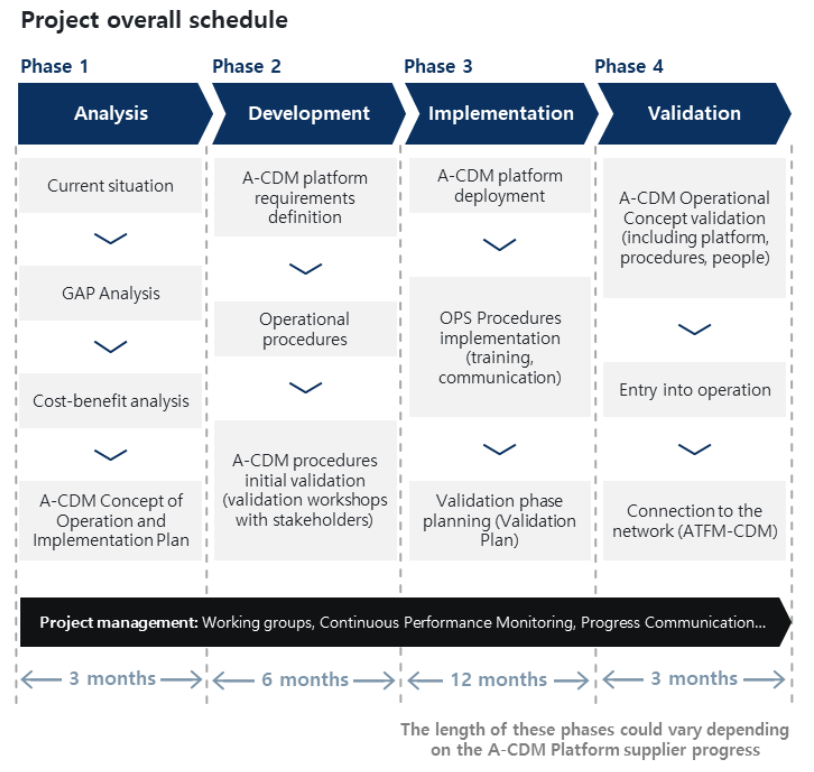Over the last 5 years, ALG has supported the implementation of the Airport Collaborative Decision Making (A-CDM) model in Latin America’s main hubs: Bogota International Airport, Lima International Airport and Mexico City International Airport.
The fast growth of the air traffic market in the region and the many challenges the airport community is facing due to the lack of communication, information sharing and common data sources required the airports to implement initiatives to improve and predict their airport operations. These initiatives are based on a strong culture of collaboration across the airport community and the air traffic network.
In a similar scenario, EUROCONTROL created the A-CDM model and started its implementation across European airports with the same goals. More than 30 European airports now have a full A-CDM implementation, outlining the next steps towards Total Airport Management.
Latin American airports are following the same path towards predictability, guided by ALG with a thorough transformation of their operations, including:
- Defining new operational procedures for the elements in the Airport CDM concept.
○ Milestones approach
○ Variable taxi times
○ Collaborative pre-departure sequence
○ A-CDM for adverse conditions
○ Collaborative management of flight updates - Adopting real-time and post-operational performance monitoring.
- Establishing a clear information sharing mechanism with the whole airport community.
- Deploying an A-CDM platform to consolidate the information and control operations.
Objectives, goals and purposes
A-CDM seeks to enhance common situational awareness and increase the predictability of real-time airports operations to solve congestion issues and optimise the Air Traffic Flow Management (ATFM). The model relies on correct and timely information sharing by the airport community: airport operators, airlines, ground handling services providers and air traffic controllers, who must now work in a collaborative decision-making environment.
In summary, A-CDM is about the right people having the right information at the right time, so they can make the right decisions.
Study methodology and activities
Deploying A-CDM is a major milestone for airports. On average, it takes two years to complete the four phases in the model, starting with analysis of current performance and identification of airport needs, through to validation of the systems and implementation of the procedures.

The methodology involves exhaustive design of the new way of operating based on new procedures, a new system, and engaged and trained stakeholders.
- Phase 1. Analysis: studying the current operational situational at the airport to identify gaps and needs for A-CDM, and the investment required from all stakeholders.
- Phase 2. Development: outlining the performance monitoring, the new procedures and the functional equipment for the A-CDM platform.
- Phase 3. Implementation: helping the airport during development and deployment (by a third party) of the A-CDM platform, to ensure the functional requirements are met, implementing the new procedures with the training of all stakeholders involved.
- Phase 4. Validation: validating the new way of operating and procedures when the system goes live,and connecting A-CDM with the ATFM network.
All of these phases involve ongoing working groups (Operations, Performance and IT) and a communication strategy to ensure engagement.
Key findings and recommendations
The A-CDM is well-known in Europe and is starting to become a reality in Latin America. EUROCONTROL’s airport CDM implementation manual is being used extensively as a guide for implementation. However, there are other considerations that have led to success for the projects ALG has been involved in:
- The analysis phase is critical. It must not be omitted, as it identifies the feasibility of the implementation and establishes firm foundations for the involvement of the stakeholders.
- All of the main stakeholders in the airports must be involved in implementation from phase one, and they must be willing to collaborate and share information.
- Performance must be monitored regularly, even if the model has not yet been implemented. This monitoring must be focused on creating a culture of continuous improvement.
- Keep the momentum going: engagement with all stakeholders is key. They must be constantly involved as the project progresses.
Success and outcomes
The project is already at the implementation phase at Bogota International Airport, Lima International Airport and Mexico City International Airport (ALG is not currently involved in Mexico implementation). All of the airports are deploying the A-CDM platform, and the stakeholders are being trained in the new way of operating.
By early 2024, these airports will all be operating A-CDM and will be able to see the operational improvements predictability will bring. The model also includes expansion of the airports, where A-CDM will be a game changer in managing future operational challenges.

